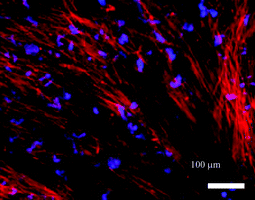Theme issue: biomedical materials
Overview
As our knowledge of biology and medicine advances, the demands for better healthcare products and biomedical materials are increasing. The diversity of these demands can be gauged by the breadth of current medical materials applications—these range from natural and synthetic polymers to aid drug delivery, hydrogels for wound dressings and contact lenses, to metals/alloys and inorganic–organic composites for implants. The importance of this field is evident when one considers that for a single type of biomedical material—drug-eluting stents—over 2.5 million patients worldwide have benefited, while the market reports value of drug delivery systems in the USA alone is predicted to reach $85 billion by 2010. The exciting recent developments in stem cell biology and regenerative medicine are further driving new applications and setting challenging targets for biomedical materials. Understanding the chemistries of materials in a biological setting is fundamental to the end applications, and chemists already play a pivotal role in the design and preparation of materials used in biomedicine. Indeed within Journal of Materials Chemistry over 50 papers have been published this year on specific biomedical materials topics, with >250 in related areas. However, while great progress has been made already, the need to address the complexities of biological systems is leading to new approaches to biomedical materials synthesis and characterisation, and a range of exciting end uses. In this theme issue, we have gathered together leaders in this rapidly evolving field of research and showcase their contributions across important connecting sectors of materials chemistry:• biomimetic and biocompatible polymers,
• implants and prosthetic devices,
• bioinorganic assemblies/organic–inorganic composites,
• drug delivery vehicles, and
• materials for regenerative medicine
One emerging theme in this issue is that of responsive, or ‘smart’ materials. For example, the chemistries of devices used in the body are often required to be dynamic or transient, such that they can respond to a biological signal to release a drug, or degrade away gradually as body tissue is restored.
Biomimetic and biocompatible polymers
Hopkins et al. describe the preparation and biological behaviour of highly branched materials based around the well-known thermoresponsive poly(N-isopropylacrylamide). RAFT polymerisation is used to build up structures that exhibit shape persistence and solution stability at temperatures up to the polymers' lower critical solution temperatures (LCST), in this case between 30–37 °C, but which become stable colloidal aggregates above LCST. Importantly, the colloidal aggregates of chain-collapsed poly(N-isopropylacrylamide) are able to penetrate human dermal fibroblast (HDF) cells, whereas the same polymers in their chain-extended conformation do not. | ||
| Fig. 1 Internalisation of fluorescent polymer particles into human dermal fibroblasts (see Hopkins et al.). Polymer-rich regions in the cells fluoresce blue with F-actin components in red. | ||
This significant result may have considerable relevance in drug delivery type applications. Grablowitz and Lendlein report the synthesis of a variant of the biocompatible polymer 1,4-dioxane-2-one (pDO), which is currently use in degradable surgical sutures. By preparing telechelic derivatives, multiblock co-polymers with a range of biocompatible co-monomers and polymers can be synthesised. The use of biocompatible poly(lactide-co-glycolide) (PLGA) materials for encapsulation and delivery is reviewed by Taluja et al., who feature complex multi-component bioconjugate encapsulation within these degradable matrices.
Implants and prosthetic devices
Implants and prosthetic devices are an important clinical area for biomedical materials. Polyethylene (PE) is widely used in implants as it is generally bio-inert, but additional functionality is difficult to introduce, limiting its use to ‘passive’ applications. Blanchemain et al. show how laser (YAG) treatment can enhance wettability of PE such that it can support cell growth, but without compromising the overall mechanical properties. | ||
| Fig. 2 Cell vitality on metal, PE and laser-treated PE surfaces (see Blanchemain et al.). | ||
Hoffman et al. report on another key area of implant materials—metal alloys—and demonstrate that TiO2 sol–gel coatings can improve cytocompatibility as well as prevent migration of toxic metal ions from vanadium and chromium based alloys.
Bioinorganic assemblies/organic–inorganic hybrids
Leonor et al. show that modification of polyethylene surfaces can be achieved such that apatite formation can subsequently take place—a key step in biomineralisation, while López-Pérez et al. describe the use of plasma treatments to render chitosan surfaces supportive to cell (in this case osteoblast) adhesion. Hoffman et al. introduce the concept of combining the biodegradable materials hydroxyapatite, chitosan and starch in layer-to-layer reactions with oxidised starch and deacetylated chitosan. They are able to produce two kinds of particles with different surfaces that form a homogeneous powder when mixed, which can then be transformed into a paste by adding water. The resultant materials can be used as a bone filler that supports cell growth. | ||
| Fig. 3 105 MC3T3 cells seeded onto bone wax substitute as described by Hoffman et al. The live–dead assay (dead cells: red, viable cells: green) shows that after 6 days cell viability is maintained. | ||
Drug delivery vehicles
Drug delivery vehicles are a demanding application area for biomedical materials and require careful design, synthesis and characterisation if they are to fulfil their therapeutic role of transporting a drug to the site in the body where it is needed, then release it in the right time and in the correct dose. Wang et al. have prepared polyelectrolyte capsules by the layer-by-layer method from cationic and anionic polysaccharides (chitosan and sodium alginate). These are used to encapsulate hypocrellin B for photodynamic therapy. The theme of ‘smart’ and biomimetic materials is also pursued by Oh et al., who review the important field of anticancer therapy based on active and triggered polymeric drug carriers. | ||
| Fig. 4 Layer-by-layer polyelectrolyte microcapsules as prepared by Wang et al. | ||
Tissue engineering
Tissue engineering materials are becoming a significant research endeavour as regenerative medicine becomes a clinical reality. Arima and Iwata consider some fundamentals of how biomolecules and cells attach to surfaces, through studies of self-assembled monolayers (SAMs) that present different functional groups to the attaching biological component. Bokhari et al. describe how high internal phase emulsion (HIPE) materials can be prepared to enhance cell growth in 3-D compared to conventional tissue culture plastics. The synthesis parameters and how these can be precisely controlled in the generation of cell-support materials are covered in this paper, and give an indication of the central role that chemistry plays in determining cell–material interactions. | ||
| Fig. 5 SEM micrograph showing MG63 cells cultured on 90% porous PolyHIPE scaffold as reported by Bokhari et al. (see text for further details). Scale bar is 25 µm. | ||
The need for a thorough understanding of all the steps towards generation of artificial tissue is further emphasised in the contribution from Chen and Hunt, who review progress in biomaterials processing for tissue engineering.
Concluding remarks
The subject of biomedical materials spans many research journals already, but it is clear, when a number of papers are brought together into a theme issue, that materials chemistry is central to this emerging discipline. I thank all the authors for their excellent contributions to this issue, and for their insights into each specialist aspect of biomedical materials. The RSC staff have worked extremely hard to bring the theme together and have kept everything to schedule—no easy feat when so many manuscripts are being mailed and revised to J. Mater. Chem. at any one time. Within the J. Mater. Chem. team Dr Neil Withers deserves a special mention for his patience and his unfailing thoroughness with the Guest Editor and reviewers!Lastly, I think this issue is a good indicator of the health of materials chemistry in its wider sense. The interface with the life sciences is very strong but the fundamentals of chemical synthesis, structure and characterisation underpin all the applications. I hope therefore that this issue will be of interest not just to the readership of J. Mater. Chem. (growing though that is!), but will serve as a central reference for researchers in biomedical materials as the field develops.
 | ||
| Plate1 Guest Editor Cameron Alexander, University of Nottingham, UK | ||
| This journal is © The Royal Society of Chemistry 2007 |
